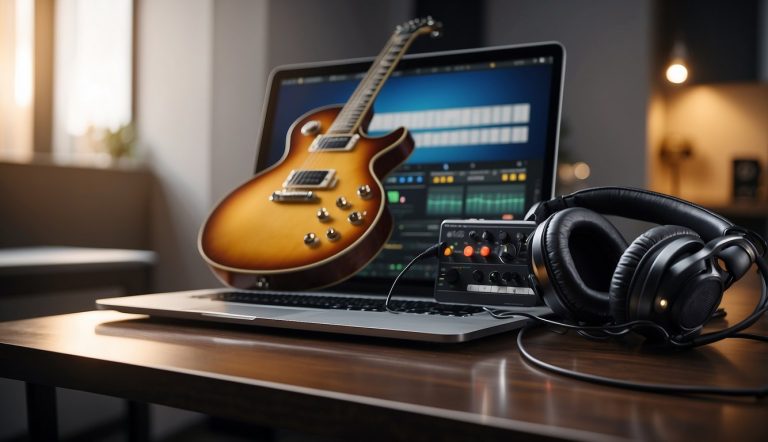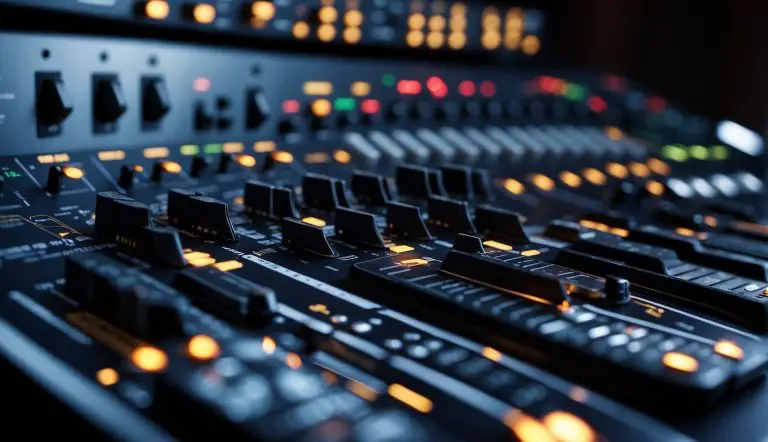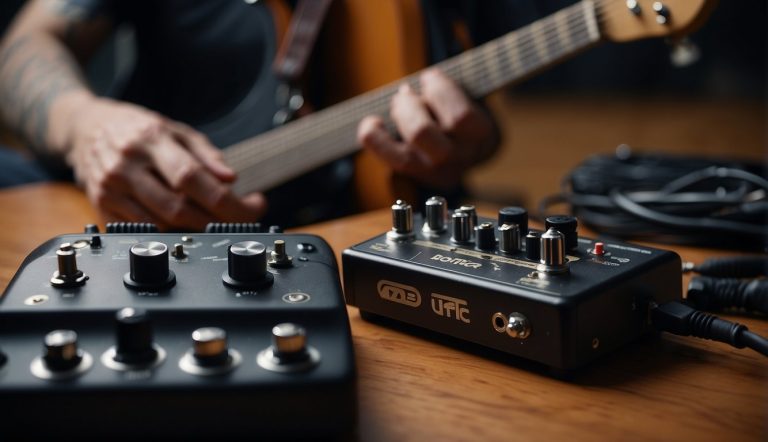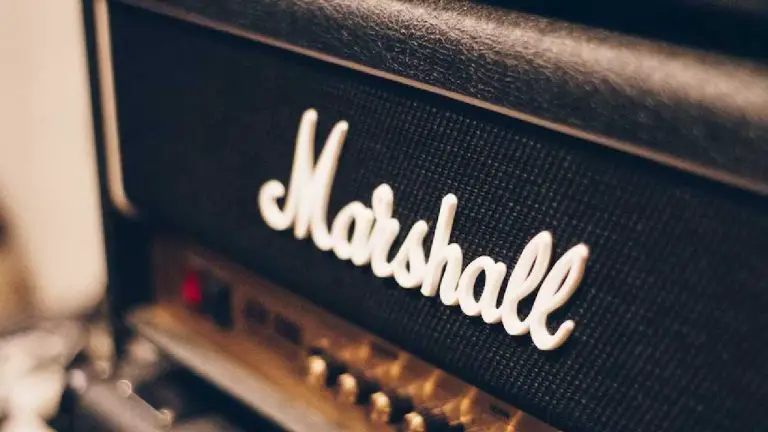Do You Need a Delay Pedal? A Friendly Guide for Guitarists
As a guitarist, you may have heard of delay pedals. But do you really need one?
Delay pedals can add depth, dimension, and texture to your sound, but they may not be necessary for every player.
In this article, I’ll explore what delay pedals are, the role of delay in music, how to use a delay pedal, and how to choose the right one for your needs.
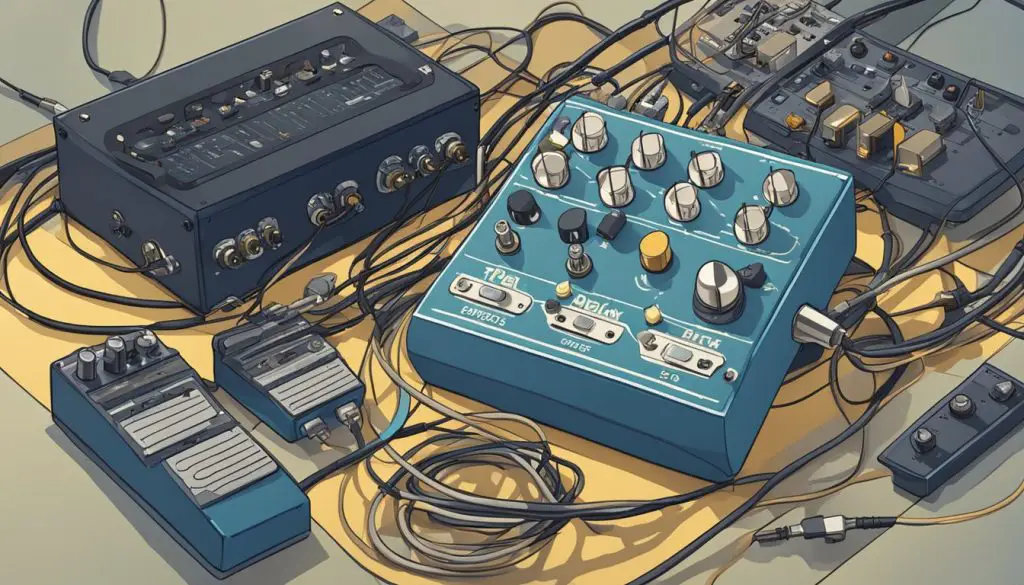
Delay pedals are a popular type of guitar effect that can produce repeats of a guitar signal, creating an echo-like effect. They can be used to create ambient sounds, add depth to rhythm sections, and create reverse playback features.
However, not every guitarist needs a delay pedal, and whether or not you need one depends on your playing style and the type of music you play.
In this article, I’ll help you determine whether a delay pedal is right for you and how to make the most of it if you decide to get one.
Whether you’re a beginner or an experienced guitarist, understanding the role of delay in music and how to use a delay pedal can help you take your playing to the next level.
In the following sections, I’ll dive deeper into these topics and help you decide whether a delay pedal is the right choice for you.
In This Article
What Exactly Are Delay Pedals?
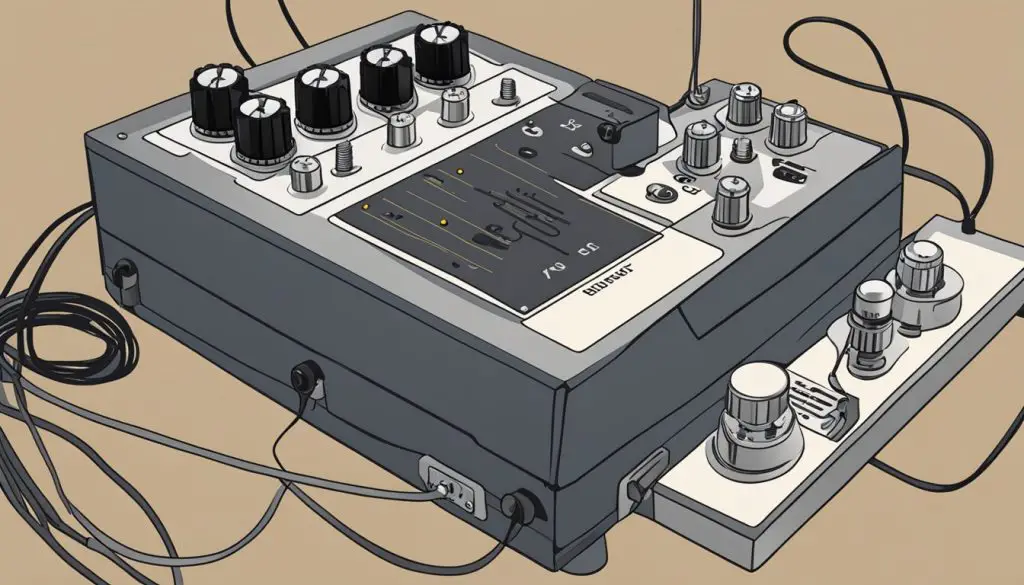
Delay pedals are a type of guitar effect that produces an echo or repeating sound after the original signal is played. They are time-based effects that can add depth, dimension, and texture to a player’s sound.
Delay pedals are popular among guitarists of all genres, from rock to jazz to blues.
History of Delay Effects
The history of delay effects can be traced back to the early days of recording technology when engineers used tape loops to create delay effects.
Later, the first analog delay pedals were created using a technology called “bucket brigade circuit” (BBD). These pedals were bulky and expensive, so they were not widely used until the 1970s.
With the advent of digital technology, digital delay pedals became more popular in the 1980s. They were smaller and more affordable than their analog counterparts, and they offered more precise control over the delay time and other parameters.
Analog vs. Digital Delay Pedals
Analog delay pedals use a BBD circuit to create the delay effect. They have a warm, natural sound that many guitarists prefer. However, they are less precise than digital delay pedals, and they can be affected by temperature changes and other environmental factors.
Digital delay pedals use digital signal processing to create the delay effect. They are more precise than analog delay pedals, and they offer a wider range of delay times and other parameters. However, some guitarists feel that digital delay pedals have a colder, less natural sound than analog delay pedals.
Key Components of Delay Pedals
Delay pedals typically have several key components, including:
- Delay Time: This controls the length of the delay, usually measured in milliseconds.
- Feedback: This controls the number of times the delay signal is repeated.
- Mix: This controls the balance between the original signal and the delayed signal.
- Modulation: This adds a subtle pitch shift to the delayed signal, creating a chorusing effect.
- Tap Tempo: This allows the guitarist to set the delay time by tapping a button or footswitch.
The Role of Delay in Music
As a musician, I have always been fascinated by the different effects that can be produced by various guitar pedals. One of the most intriguing effects is delay. In this section, I will discuss the role of delay in music and how it can enhance your playing.
Creating Ambience
One of the primary uses of delay is to create ambience. By adding a slight delay to your guitar signal, you can create a sense of space and depth to your sound. This effect is commonly used in genres such as post-rock and shoegaze, where creating an ethereal atmosphere is crucial. The delay effect can help to fill out the sound and make it more immersive.
Enhancing Guitar Solos
Delay can also be used to enhance guitar solos. By adding a longer delay time to your signal, you can create a repeating echo effect that can add a sense of drama and tension to your playing. This effect is often used by guitarists such as U2’s The Edge and Pink Floyd’s David Gilmour to create soaring, emotional solos.
Rhythmic Layering
Another way that delay can be used is to create rhythmic layering. By setting the delay time to a specific beat, you can create a repeating pattern that can add depth and complexity to your playing. This effect is commonly used in genres such as reggae and dub, where creating a complex rhythm is crucial.
How to Use a Delay Pedal
Delay pedals are a great way to add depth and texture to your guitar playing. They can create an echo-like effect that can enhance your sound and give it a unique character. In this section, I will explain how to use a delay pedal and provide some tips on how to get the most out of this versatile effect.
Setting Delay Time and Feedback
The first thing to consider when using a delay pedal is the delay time. This is the amount of time between the original signal and the delayed signal. You can adjust this time to create a range of different effects. For example, a short delay time will create a slap-back effect, while a longer delay time will create a more pronounced echo.
Another important setting is the feedback. This controls how many times the delayed signal is repeated. You can adjust this to create a subtle echo or a more pronounced effect. Be careful not to set the feedback too high, as this can create an unwanted feedback loop.
Manipulating Tone and Level Controls
Most delay pedals come with tone and level controls. The tone control allows you to adjust the tone of the delayed signal. You can use this to create a darker or brighter sound. The level control adjusts the volume of the delayed signal. You can use this to ensure that the delayed signal is balanced with the original signal.
Incorporating Tap Tempo and Subdivisions
Many modern delay pedals come with tap tempo and subdivision features. Tap tempo allows you to set the delay time by tapping a footswitch. This is a great way to create rhythmic effects that are synced to the tempo of the song. Subdivisions allow you to divide the delay time into smaller increments. This is useful for creating complex rhythms and syncopated effects.
Choosing the Right Delay Pedal
As a guitarist, choosing the right delay pedal can be overwhelming, especially with so many options available on the market. I have researched and tested various delay pedals and have come up with a few important features to consider when choosing the right one for you.
Features to Consider
Analog vs. Digital Delay Pedals
Analog delay pedals produce a warm, natural sound and are great for vintage-style effects. On the other hand, digital delay pedals offer more versatility and precision in terms of delay time and modulation.
If you’re looking for a classic sound, go for an analog delay pedal like the MXR Carbon Copy. If you prefer more modern sounds, a digital delay pedal like the Boss DD-7 might be a better choice.
Tape Delay Pedals
Tape delay pedals emulate the sound of old tape echo units and produce a warm, saturated sound. They are great for creating a vintage feel and are often used in genres like rock and blues.
If you’re looking for a tape delay pedal, the Strymon El Capistan is a great choice.
Echo Pedals
Echo pedals produce a repeating delay effect and are great for creating ambient soundscapes. They are often used in genres like post-rock and shoegaze.
If you’re looking for an echo pedal, the Boss RE-20 is a great choice.
Top Delay Pedal Recommendations
Based on my research and personal experience, here are some of the best delay pedals on the market:
| Delay Pedal | Features | Price |
|---|---|---|
| MXR Carbon Copy | Analog, Warm Sound | $149 |
| Boss DD-7 | Digital, Versatile | $159 |
| Strymon El Capistan | Tape, Vintage Sound | $399 |
| Boss RE-20 | Echo, Ambient Soundscapes | $259 |
Integrating Delay Pedals into Your Rig
Delay pedals are a great addition to any guitarist’s rig. They can add depth, texture, and dimension to your sound, and can be used in a variety of ways to create different effects. Here are some tips on how to integrate delay pedals into your rig.
Pedalboard Placement
When it comes to pedalboard placement, there is no right or wrong way to do it. Some guitarists prefer to place their delay pedal at the end of their signal chain, while others prefer to place it closer to the beginning.
Personally, I like to place my delay pedal after my overdrive and distortion pedals, but before my modulation pedals like phaser and chorus.
Combining with Other Effects
Delay pedals can be combined with other effects to create unique sounds. For example, combining a delay pedal with an overdrive pedal can create a rich, full-bodied sound with a lot of sustain.
You can also combine a delay pedal with a wah pedal to create a cool, sweeping effect.
One of my favorite ways to use a delay pedal is to combine it with a phaser pedal. By setting the delay time to match the speed of the phaser, you can create a swirling, ethereal sound that is perfect for creating ambient textures.
When combining your delay pedal with other effects, it’s important to pay attention to your signal chain. Make sure that your pedals are connected in the correct order, and that your delay pedal is receiving a clean, unaltered signal from your guitar.
Frequently Asked Questions
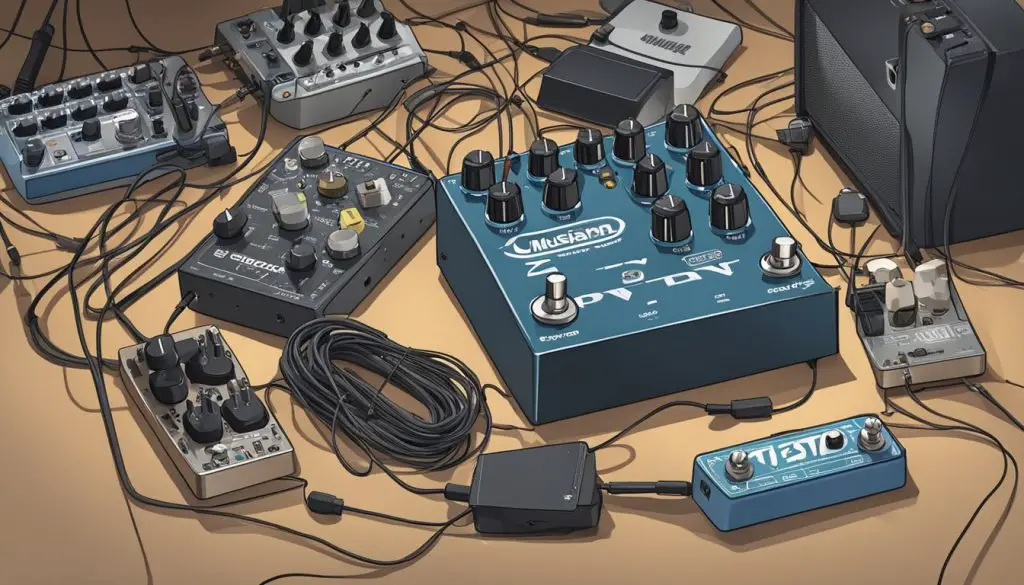
What are the benefits of using a delay pedal for electric guitar?
A delay pedal is an essential tool for any electric guitar player. By adding a delay effect to your guitar tone, you can create a sense of space and depth in your sound.
This effect can be used to add a subtle echo to your playing or to create complex rhythmic patterns.
Additionally, a delay pedal can help you to create a fuller and more dynamic sound by adding layers of sound to your playing.
Can an acoustic guitar benefit from a delay pedal?
Absolutely! While delay pedals are most commonly associated with electric guitars, they can be used just as effectively with acoustic guitars.
By adding a delay effect to your acoustic guitar tone, you can create a sense of space and depth in your sound, just like with an electric guitar.
This effect can be used to add a subtle echo to your playing or to create complex rhythmic patterns.
How does a delay pedal enhance your music?
A delay pedal can enhance your music in a number of ways. By adding a sense of space and depth to your sound, a delay pedal can help to create a more immersive listening experience.
Additionally, a delay pedal can help you to create complex rhythmic patterns and add layers of sound to your playing, making your music more dynamic and interesting.
What’s the difference between delay and reverb effects?
While both delay and reverb effects can be used to create a sense of space and depth in your sound, they work in slightly different ways.
A delay effect creates an echo by repeating the original sound at a set interval, while a reverb effect creates the illusion of a large space by simulating the sound reflections that occur in a room.
In general, delay effects are more rhythmic and precise, while reverb effects are more ambient and diffuse.
Which should I invest in first: a delay or reverb pedal?
If you’re just starting out, it’s generally a good idea to invest in a delay pedal first. Delay effects are more versatile and can be used in a wider range of musical styles and genres.
Additionally, delay effects are more rhythmic and precise, which makes them easier to use in a musical context. Once you’ve mastered the delay effect, you can then consider investing in a reverb pedal to add more depth and ambience to your sound.
What are the key features to look for in a top-rated delay pedal?
When shopping for a delay pedal, there are a few key features to look for.
First, you’ll want to consider the type of delay effect that the pedal produces. Analog delay pedals produce a warmer, more natural sound, while digital delay pedals offer more precise control and a wider range of delay times.
Additionally, you’ll want to consider the number of delay settings that the pedal offers, as well as the quality of the feedback and mix controls.
Finally, you’ll want to consider the build quality and durability of the pedal, as well as any additional features or effects that it may offer.


